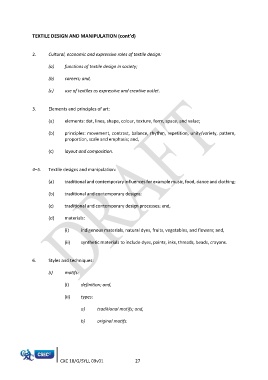Page 1428 - SUBSEC October 2017_Neat
P. 1428
TEXTILE DESIGN AND MANIPULATION (cont’d)
2. Cultural, economic and expressive roles of textile design:
(a) functions of textile design in society;
(b) careers; and,
(c) use of textiles as expressive and creative outlet.
3. Elements and principles of art:
(a) elements: dot, lines, shape, colour, texture, form, space, and value;
(b) principles: movement, contrast, balance, rhythm, repetition, unity/variety, pattern,
proportion, scale and emphasis; and,
(c) layout and composition.
4–5. Textile designs and manipulation:
(a) traditional and contemporary influences for example music, food, dance and clothing;
(b) traditional and contemporary designs;
(c) traditional and contemporary design processes; and,
(d) materials:
(i) indigenous materials, natural dyes, fruits, vegetables, and flowers; and,
(ii) synthetic materials to include dyes, paints, inks, threads, beads, crayons.
6. Styles and techniques:
(i) motifs:
(i) definition; and,
(ii) types:
a) traditional motifs; and,
b) original motifs.
CXC 18/G/SYLL 09v01 27

